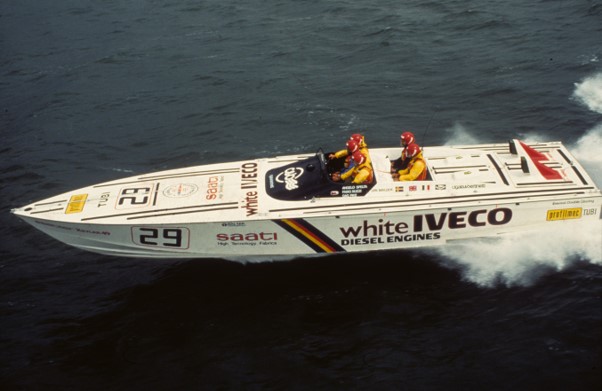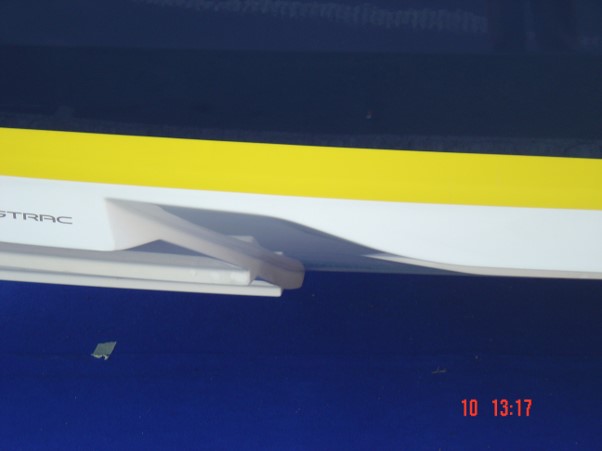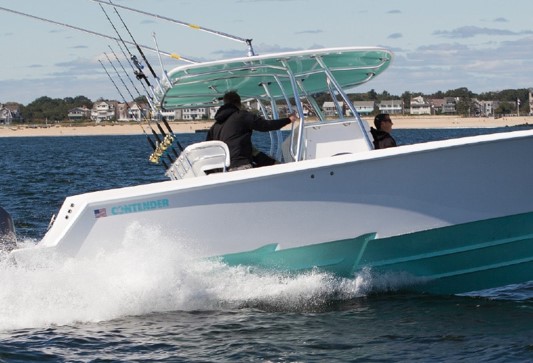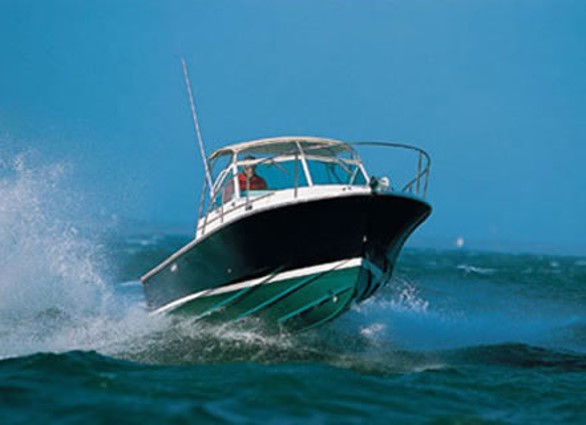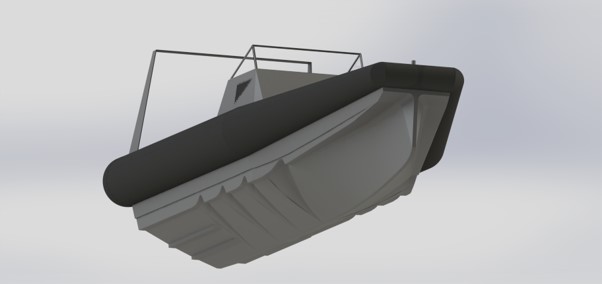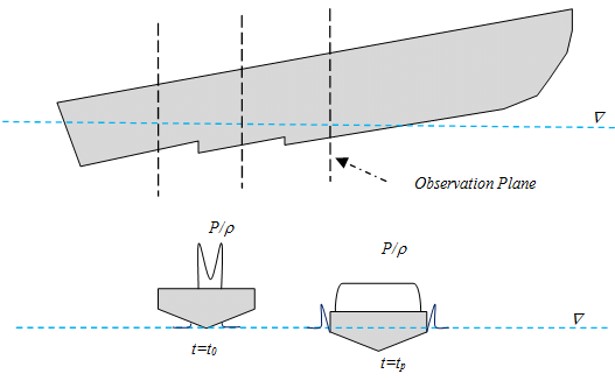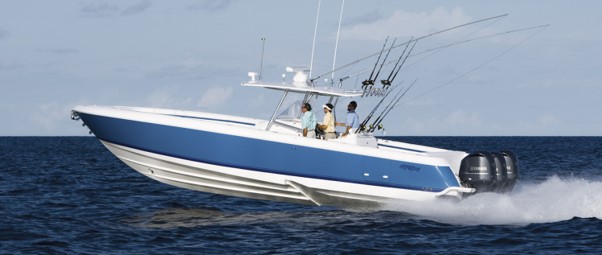Watch Your Step
Deep-Vee Makeover
Fast deep-vee boats are increasingly using stepped hulls. Most of the time you don’t see them because they are hidden away on the bottom of the boat, but the theory of hull steps is to gain speed by reducing the hydrodynamic drag. Also, hull steps can improve pitch control in a seaway so you get a more stable ride. So, they are a win-win development.
The concept of using stepped hulls is not new - they go back over 100 years. But it is thought that the first time they were used in a deep-vee hull was when Fabio Buzzi introduced a step in the bottom of White Iveco, the boat in which we won the second Round Britain Race back in 1984. This was a big boat with four heavy diesels for power. The idea of the step was to compensate for this heavyweight in the stern and give a better ride.
This put the longitudinal center of gravity (LCG) close to amidships so the step, also close to amidships, of a stepped hull carried most of the weight, with the stern acting mainly as a trim control surface. They could be fast and efficient at a specifically-designed weight, which was fine for racing but caused problems with load-carrying craft.
Engine Matters
Since the introduction of stern drives, pod drives and large outboard motors, the engine and other weights in deep-vees have been concentrated aft. Hulls are designed around this aft longitudinal center of gravity (LCG) position, which allows much better load carrying. This opens opportunities to take advantage of steps.
Performance Gains
A gain in performance of around 8% - 12% can be obtained from using steps, compared with similar non-stepped hulls because they reduce the hull resistance. The two main components of hydrodynamic drag are wave-making due to the water being thrown aside and the friction of water on the underwater surfaces. As speed increases, the wave-making resistance reduces whilst the skin friction increases. This friction drag is proportional to the wetted surface area, the bits of the hull in contact with the water and steps can help to reduce this.
Spread this point of contact between two parts of the hull as you do with a stepped hull, so there are more of these high pressure ‘leading edges’ but less length of inefficient wetted surface behind them. Thus, the average pressure over a stepped hull is increased, reducing the wetted area and the skin friction.
With a stepped hull supported by two or more of these high-pressure areas, the steps offer a pitch stabilizing influence. Stepped hulls have increased resistance to porpoising. Further efficiency is gained by being able to run the surfaces at higher angles of attack than you can with a non-stepped hull. The pressure increase of a higher angle gains a further reduction in the wetted area, reducing friction.
Can any boat have a stepped hull?
Steps require ventilation to avoid creating suction. The lack of an air feed to the step can cause the step face to stay wetted and drag an enormous quantity of water, which kills performance. Air normally feeds from the chines, which are often opened up to encourage this. Poor ventilation can sometimes make the hull challenging to get planing, and trunking air in the void behind the step can help. Even ventilation is also important in order to avoid erratic course keeping as the resistance might vary from side to side.
It is not worth incorporating steps for low planing speeds so that for a 30-footer, it would need to be capable of around 35 knots to justify steps. With larger boats, this threshold where steps are viable becomes higher. Then we need to consider the directional stability of the hull, which required the lateral center of pressure (LCP) to be aft of the LCG for an acceptable performance. Looking at the hull from a side-on view, the LCP is roughly the center of the wetted surface or underwater area when planing.
This underwater planing profile is a long triangle with the deepest part at the transom for a non-stepped hull. Introduce steps and the profile changes to a series of smaller triangles. The LCG of a twin stepped hull would normally be a little forward of the aft step to give directional stability. Allowing the combined LCP to be forward of the LCG can give directional instability. So what might be the most efficient arrangement for planing might not work for effective steering - therefore a compromise is required. It is often claimed that modern stepped hulls can be more prone to hooking or spinouts when turning, but this is largely the result of poor design.
On some production stepped hulls, there were sometimes complaints from boat testers that the boats seemed to try to hook when turning.
With a non-stepped hull, it is normal to trim the drives in when turning if they are trimmable drives, but with a stepped hull it is important not to trim in too far so that the hull remains balanced during the turn.
If steps are not too deep or too far aft so that the aft surface is properly wetted, directional stability should be fine. If a boat hull, whether stepped or non-stepped, has a shape that causes high heel in turns then the loss of grip aft can result in a spin or hook. Also, where the deadrise is low, lack of immersion aft can give the same result, whether stepped or non-stepped.
The Hull Difference
A stepped hull has an advantage in a seaway with better pitch control making for higher speeds and an easier ride. When a fast, non-stepped hull meets a wave, the impact causes the bow to rise. This is accelerated as the pressure travels aft. When the pressure passes the LCG, momentum makes the bow rise but the pressure, which is now high, due to the high angle of attack, lifts the stern, such that the craft leaps clear of the water with a bow high attitude. Falling back stern first, it impacts hard due to the high angle and this kicks the stern up again, while pitching the bow down hard, which buries itself to a greater or lesser extent depending on the reserve lift. If this is lacking or the bow impacts the face or back of another wave, the craft can nosedive under hard driving. These violent attitude changes and impacts are very uncomfortable for both craft and crew and they waste energy whilst the propeller thrust is not pointing in the direction of travel for much of the time.
The next pulse, with a twin step boat, hits the next surface just ahead of the 2nd step, but this is almost directly under the LCG so the boat lifts bodily but the bow up angle does not increase. The next impulse hits the aft surface lifting the stern and countering the previous bow lift. The net result is that the hull lifts much less and at a much more level attitude, spending less time in the air. Reduced distance to fall and a lower angle, mean lower impact, and the propellers spend more time immersed with the thrust mainly horizontal.
Twin steps offer more tolerance of variable LCG position and three (or more) steps can have advantages from the point of view of minimizing wetted surface, depending on the hull proportions and loading.
Lorne Campbell, a British designer with considerable experience of stepped hulls commented, “For planing craft requiring high cruising and maximum speeds for the majority of their work envelope, steps are a valid way of reducing the power requirement and improving the ride. If properly designed and driven, the boat will handle in a perfectly acceptable manner and not ‘bite’ its driver! Craft which have to spend much time at low and off-plane speeds are possibly not the right candidates for steps, but in the correct performance area their advantages should not be ignored.”
